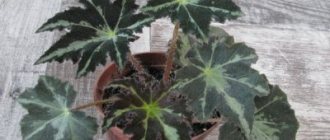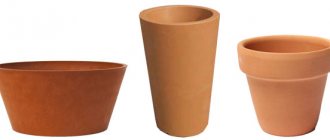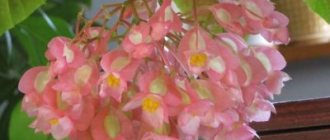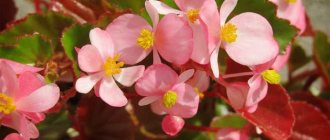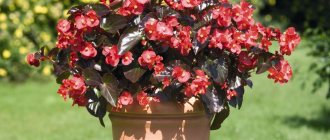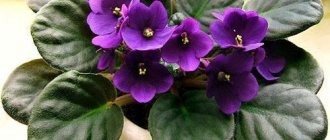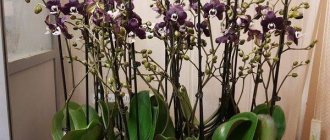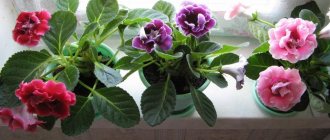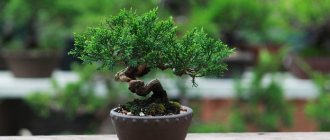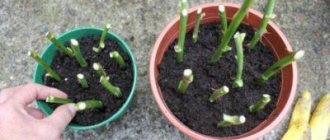Begonia - care at home, can it be kept at home?
These flowers have been growing in our apartments for so long that we have already begun to perceive them as something “our own.” Meanwhile, all these flowerpots were once brought from warm overseas countries: Madagascar, tropical forests of Asia, Africa and even America. And if in our country begonias mostly “huddle” on window sills, then in their homeland they bloom “in the wild”, nestling in the crevices of stones and even in the roots of large trees.
And the very first flower known to Europeans was described by the French monk C. Plushier, who came to the island of Haiti in the 18th century. Admiring the hitherto unprecedented (although at that time rather modest) flower, the monk named it in honor of Michel Begon, the then governor of the island, with whose “blessing” this botanical expedition was organized.
Currently, about 900 species of begonias are known . These can be either tiny plants (no higher than 10 centimeters) or three-meter giants. True, gardeners around the world are interested in only 120 species - the rest live freely in the wild. Moreover, among them there are not only herbaceous flowers, but also subshrubs, epiphytes (roots cling to large trees) and even vines.
Houseplant begonia - types
Not only are there a lot of these flowers. To the existing species we must also add hybrids created by people (and there are already about 2 thousand of them).
Flowers grown in houses can be divided into decorative deciduous (if they bloom, it is very modest and infrequent) and decorative blooming.
The most popular “leaf”:
Royal.
Also known as rex begonia. Due to its popularity, it has many varieties that differ in the shade of the leaf blades. The species can be recognized by its large (up to 30 cm) leaves with uneven coloring, attached to a creeping, thick stem. They can be reddish, brown or dark green in color, and snail-shaped or heart-shaped in shape.
Tiger.
A twenty-centimeter bush, “folded” of small green leaves, decorated with contrasting spots and relief veins.
They sometimes bloom, but experienced gardeners know: the flowers of leaf begonias are almost invisible, and they “eat up” the bush, stealing valuable resources from the soil. Therefore, as soon as they see the flower stalks, they are immediately cut off, not allowing the plant to even enter the flowering phase.
Commonly sold flowering begonias:
Tuberous.
They can delight with both simple and double flowers. There are varieties with orange, scarlet, yellow, pink, white, as well as multi-colored petals (say, with mixed shades or a contrasting border). You can compare such flowers with peonies, carnations, and roses. Depending on the variety, the diameter of the flowers varies between 5 and 15 cm.
The most popular hybrid of this species is begonia elatior , which is also beautifully flowering. This potted plant blooms very generously and luxuriantly, from autumn to winter (less often in summer). Tender shoots of a flower often cannot withstand heavy flowering, so you need to immediately plan supports for them. The bush grows upward by about 35 cm.
The second successful tuberous begonia is Lorrain . It is taller (stretches up to 50 cm). Lorrain can be recognized by its leaves, which have a characteristic wavy line along the edges, as well as small, but very often blooming flowers.
Ampelous.
A subspecies of tuberous begonia, which has long shoots growing up to 25 or even 50 cm. All these “garlands” are generously decorated with yellow, orange, crimson or white flowers.
Bushy.
These flowers grow from a regular root and do not need wintering.
Of these, the most popular are ever-flowering . They are as “unkillable” as possible. They are grown in open ground (in flower beds) or in indoor pots. In the latter case, the plant can bloom all year round, which is why it got its name. The flowers of this begonia are relatively small, white, pink or red.
Coral begonia
It is also called coralline , so named because of its bright pink flowers. Its large leaves, growing up to 15 cm, are decorated with light dots.
Interesting: Indoor Azalea - caring for the plant at home
Bright red got its name because of the hue of the flowers, which form bright panicles.
Botanical description and history
Begonia Fista is otherwise called Red-leaved (other varieties of begonia with red leaves are described in detail in this article). Her homeland is South America. This plant variety has round, fleshy leaves that grow up to 12 cm wide and 15 cm long. Light green stems:
- short;
- strong;
- fatty.
The root system is powerful and capable of developing quickly.
Caring for begonia in a pot at home
In general, it is not complicated: the flower does not require heat, frequent changes of soil, frequent spraying (which gardeners always forget about). True, in dry air this tropical woman can still get sick.
And some types of begonia need wintering.
Lighting
- Flowering varieties love bright light . But it should not be direct (otherwise the leaves are in danger of being burned), but scattered. Remember: begonias came to us from the tropics, where they grew under huge trees, protected from the sun by lush foliage. Once on a southern windowsill in the summer, such a flower will immediately begin to suffer. So you can send the flowerpot “to the south” only in winter, and in other seasons keep it on the western or eastern window.
- Leafy plants prefer partial shade . But they will also like a western or eastern window.
By the way! If you plan to highlight other flowerpots in winter, begonia can also be sent to this “company”. But do not forget: phytolamps (ice) can be hung low above the flowers, as they do not heat up and will not dry out the leaves of this flower. If you decide to use a regular tabletop with an incandescent lamp, remember that such a light bulb heats up during operation - it should be located 50 cm or higher from the flower.
Temperature
This plant does not like heat. He is comfortable at 18-20 degrees (all year round). In winter, the temperature in the room may drop slightly, but not below 15 degrees.
Do not forget! In winter, the temperature on the window in front of the curtain (essentially in the room) and behind the curtain (in front of the glass) can differ significantly. Check it, especially in severe frosts!
In addition, remember: begonias get sick in musty air, but are afraid of drafts. Also, this capricious plant can wither if the air in the room is polluted (therefore, these flowers rarely take root in the apartments of smokers).
Humidity in the room
This flower loves high humidity . But at the same time, most species do not like spraying (this procedure may cause dark spots to appear on the leaves).
A way out of the situation can be found as follows:
- keep the flower near the aquarium;
- a humidifier should be running in the room (at least during battery season);
- prepare a decorative tray with sea pebbles, expanded clay or moss, place a flower pot in the center, water these pebbles often: the water will evaporate and humidify the air.
If you have a democratic ever-blooming begonia that grows well on an open balcony or under the house (and is not afraid of dew and rain), it can be pampered by spraying even during flowering.
Watering
- The water should be soft. Leave it taken from the city tap for 24 hours in an open jar.
- The pot should have a tray where all excess will drain. Drain off this excess.
- In summer, the flower is watered generously, once every 3-4 days. But if the apartment is very hot, you can water it every day, in the morning or evening (in the hottest sunshine, plant roots do not absorb moisture well).
- In autumn (from the beginning of October) the flower is watered only “on demand”, that is, when the soil in the pot dries out.
- In winter it is watered to a minimum. It is necessary to prevent excess moisture - in the cold season it can cause rotting of the roots or stem. And tuberous begonias don’t need to be watered at all (if the plant has gone dormant).
- In the spring, with the arrival of warmth, watering should be gradually increased.
Nutrition
The more luxuriantly a flowerpot blooms, the more nutrients it needs.
Mineral fertilizers are suitable for these flowers.
The easiest way is to buy a specific one (“For begonias”) and fertilize the flowerpot according to the label.
You can also find “For violets and begonias” in stores. Sellers assure that this crop is also suitable for fertilizing “For violets” (it’s the easiest to buy).
But if you don’t find it either, buy a complete mineral fertilizer (universal). But don’t forget about what type of flower you are growing!
For rex and the like, look for a “mineral water” for decorative deciduous crops (with a high percentage of nitrogen in the composition), and for flowering ones, look for fertilizer for indoor flowers with potassium and phosphorus.
It is necessary to feed the flowerpot during intensive growth of buds and flowering. For most species, this is spring and summer, although some flowers, on the contrary, bloom in winter, and the ever-blooming one can “express itself” all year round. As a rule, two deposits per month should be sufficient.
Begonia - wintering at home
You can care for begonias in winter in the same way as you are used to. Just add additional lighting , especially if the plant is blooming. The flower needs light, even if the bush has faded and has been pruned (it no longer needs “empty” flower stalks). It will continue to grow leaves, and after resting, it may bloom again.
Some tuberous begonias lose all their leaves, requiring special wintering . You need to dig up a tuber from such a flowerpot, hide it in dry peat or sand, do not water it, store it at 10 degrees (that is, in the bottom drawer of the refrigerator, on an insulated balcony or in the cellar). In the spring, the nodule returns to the ground, is watered, germinates again, and blooms in the summer.
And if you don’t have enough time to replant, just leave the tuber in the old soil, but make sure it dries well before storing.
Trimming
The bush does not need shaping. But sometimes its form suffers (say, due to the loss of leaves due to illness, or cutting off faded peduncles). If such a flowerpot looks ugly, you can trim it, leaving only 4-5 cm (you need to measure above the edge of the pot).
This procedure encourages the begonia to bush, “launching” the lateral buds.
Important! Use the sharpest knife possible. When pruning, it is necessary that the stem does not become wrinkled or become wet, otherwise it will rot.
How to replant begonias
This is a flower with a rather fragile “body”, so there is no need to bother it with frequent transplants. One transplant every 2-3 years will be enough . Look at the pot, especially at the hole for draining the water: if the roots are sticking out everywhere, it means that the begonia’s roots are cramped in the old “house”, and it’s time to buy a new one.
A good time for transplantation is the first weeks of March .
a pot 2-3 cm wider than the old one. It is better not to take very voluminous ones - even flowers with a large “crown” have compact roots. For an adult rooted plant, a 0.7 liter pot is enough. To plant tuberous flowers, you need to look at the size of the tuber.
Old soil from the roots must be removed. It is carefully removed by hand, after which the root system is placed in a basin with a barely pink solution of potassium permanganate for 60 minutes. This will help to wash off the old, “empty” soil and lightly disinfect the roots.
After this, subject your flower to a thorough inspection. Cut off anything that seems rotten.
By the way! After planting, water the flower thoroughly once, and again the next day.
Soil selection
This plant loves nutritious, “fat” soil .
As with fertilizer, it is better to buy a ready-made, balanced composition. By the way, this flower does not have such unique “tastes.” The same store sellers can offer you soils that manufacturers label as “Soil for roses and begonias.” A substrate created for gardenias, coleus, and balsam is also suitable.
If you want to do everything yourself, use:
- 2 parts of deciduous soil (it can be collected from a deciduous forest or in a garden);
- 1 part chernozem (or purchased humus);
- 1 part peat.
Moreover, these ingredients do not have to be mixed. When planning to transplant a flower, first pour expanded clay onto the bottom of the pot, then clean coarse sand (drainage). Then fill up to half the volume of the pot with deciduous soil, and after installing the begonia, add a mixture of black soil and peat.
Landing Features
Despite its delicate and fragile appearance, red begonia has high vitality and can be reborn even from a small piece of leaf. The planting technology is not particularly difficult, but it requires care and compliance with some subtleties.
Optimal time of year
Planting must be done in the following cases:
- After purchasing in a store . Experienced flower growers advise moving the plant to a new container with new soil immediately after purchasing it at the flower market. The fact is that in store conditions the flower is grown in special soils that are not suitable for home cultivation of begonias.
- With strong growth of the root system . When the roots begin to stick out of the container, the crop should be transplanted into a new, more spacious pot, otherwise it will slow down in growth and drop flowers.
It is best to plant begonias in the spring, after they have completely bloomed.
Important! A flower can be transplanted after purchasing it at any time, regardless of seasonality.
Choosing a pot and preparing the soil
When planting begonias, it is extremely important to take care of choosing a suitable pot. Since the root system of the flower is not characterized by strong and powerful development, experts advise choosing a container that is not very deep and wide. To prevent the roots of the crop from rotting and moisture from stagnating in the container, you need to take a small container, approximately 14 cm in diameter. When subsequently replanting a flower, you should choose a pot 1-2 cm larger than the old one. The material of the container does not matter much, but it is better to give preference to containers made of ceramics, glass or plastic.
As for the soil mixture, loose, fibrous soils are ideal for begonias, which can be purchased at flower shops or made yourself.
For the last option you need to mix:
- leaf soil - 2 parts;
- peat - 1 part;
- chernozem - 1 part;
- rotted manure - 10%.
Immediately before planting the crop, the soil must be disinfected by calcining it for 25–30 minutes in the oven at a temperature of +180°C or spilling it with a weak solution of potassium permanganate.
Optimal conditions
Red begonia prefers good, bright, but diffused light, and can also thrive in light partial shade. Direct sunlight is destructive to the flower, the impact of which can lead to burns on the foliage.
We advise you to read why begonia leaves dry out.
The optimal temperature indicators for begonia are considered to be +21…+23°C during the daytime and about +18°C at night. In winter, it is allowed to reduce the temperature to +15…+18°C.
Due to its tropical origin, the plant loves high humidity, but has a negative attitude towards surface spraying. When moisture gets on the foliage, brown spots form, which subsequently turn into putrefactive areas. If the level of humidity is insufficient, it is recommended to place the container with the flower in a tray with water or install additional sources of moisture near the flower: indoor fountains, air humidifiers, tanks with fish, etc.
Landing technology
Planting begonias is a fairly simple process and is based on the following steps:
- Before planting in the ground, conduct a thorough visual inspection of the root system. All rotten, dry, damaged areas are removed, the roots are soaked for 20–40 minutes in any solution of a fungicidal preparation.
- A small layer of drainage is poured into the bottom of the prepared container, which can be expanded clay or small pebbles. The drainage layer should occupy no more than 10% of the volume of the entire pot.
- Loose soil is poured onto the drainage layer, on which the tuber is planted “shoulder-deep”. When planting, it is very important not to deepen the tuber too much.
- The plant is sprinkled with soil and watered.
Important! Until the begonia takes root, it should be watered along the edge of the pot. Also, during the plant’s adaptation period, approximately 1 month, it should not be exposed to the sun.
Indoor begonia - cultivation and propagation
Cuttings
This method is used in the spring or summer months.
Stem (twig)
Its length should be from 7 cm.
Do not dry out the cutting - immediately after cutting, plant it in a moistened mixture of peat and sand, taking three parts more of the first than the second (although many gardeners germinate begonia in ordinary water).
You need to keep the glass with the cutting in a dark place. Don't forget to lightly water it and also spray it. But there is no need to keep it in a greenhouse (an inverted bag) - in such conditions the branch may become covered with fungal spots.
It will germinate 30-45 days later. Don't expect a long “beard” from the roots. As soon as you see a few roots, plant the cutting in “adult” soil and care for it like a mature flowerpot.
Leafy
Choose the healthiest and strongest leaf.
Dig the cutting into a pot of soil (sand + peat or soil for begonias) so that the leaf blade itself remains on the surface without touching the soil.
Keep the pot in the shadiest room possible. And when you see that new small leaves appear on the surface of the leaf, you can place the pot on the western or eastern windowsill.
By the way! If there is only one leaf (you asked it from a friend) and you want to make many flowerpots from it, you can cut it into several pieces and stick each one sideways into the ground. In this case, each (or most) cutting will produce a sprout.
Tubers
The tuber can be planted from February to June.
Everything is done in several stages:
- Plant the tuber 50% into the soil.
- Let it sit in a dark, cool room. Water very carefully. So he will “wake up”.
- Having seen that the tuber has been decorated with several shoots, you can add more soil, completely hiding the tuber.
- Now the pot can be placed on the window.
By the way! Tubers can be separated . But not all gardeners go for such manipulations - this part of the flower is extremely delicate, and if you make a mistake in something, the tuber may die.
The sprouted (with sprout) tuber is cut into 2 parts, each with at least one bud remaining. To disinfect, sprinkle the cut areas with crushed charcoal (pharmaceutical activated charcoal is also suitable). After this, immediately plant the divisions in the ground.
Seeds
It is better not to collect them from home flowers, but to buy them (many modern begonias are hybrids, and their seeds can only disappoint, not conveying the characteristics of the mother bush).
Seeds need to be germinated from December to March.
Mix leafy soil, sand and peat (you can put pieces of polystyrene foam at the bottom of the tray for drainage). Spray. Spread the seeds over the surface, slightly pressing them into the soil.
They should germinate in 10-15 days.
When the plants acquire real leaves, plant them (you can still put them in a common pot, but with a large interval between plants). When the seedlings get stronger and grow, transfer the flowers to separate pots.
Such begonias can bloom as early as July. If it is a tuberous plant, a nodule should grow by winter.
Reproduction methods
Begonia fimbriata reproduces in the following ways:
- By dividing the tuber;
- By cutting method;
- Using seeds.
Let's look at each method in more detail.
Tuber division
Separation of begonia tubers is the simplest method of propagation and is carried out as follows:
- The tuber is cut into several parts.
- Tuber sections are processed using wood ash.
- Divided tubers must be planted in a pot or open ground.
Tubers can be divided only after three or four buds have formed.
Cuttings
Another effective method of reproduction, which is carried out in the following order:
- A cutting 8-12 centimeters in size is separated from the main bush.
- The selected cutting is placed in pre-prepared soil.
- After the seedling has given roots, it should be transplanted into another pot and the top trimmed, which will give the future bush fullness.
The end of spring is the most favorable period for taking cuttings . The planted cuttings take root within 20-30 days.
Using seeds
To plant begonias, purchased seeds are used, because... It is quite difficult to get them at home - each inflorescence will need to be pollinated by hand.
Planting is done as follows:
- Take a medium-sized container and fill it with garden soil.
- We sow seeds directly on the surface of the ground. If they are small, they should be mixed with sifted sand.
- Spray the seeds with water and cover the container with film. When the first shoots appear, the film can be removed.
You can speed up the germination procedure with the help of the drug "Epin" - a growth stimulator.
At the end of the summer season, the tubers should be dug up and stored in a cool, dry place.
Begonia diseases and their treatment at home
The flower is not feeling well
- The flowerpot is not blooming . The reasons for this annoying misunderstanding can be different: too dark a room, dry air, drafts. The soil may also be to blame, “clogged” with salts (don’t forget to settle the water?), or stuffed with the wrong fertilizers - for example, if you feed a flower begonia with nitrogen, it will all turn into leaves instead of flowering. Finally, an old bush that needs to be rejuvenated (cut off the best branches and root, and throw away the “mother”) may not bloom.
- The buds are falling . Most likely, the flower is starving; it has not been fed for a long time. The reason may also be a lack of watering.
- Each new leaf grows smaller than the others . Begonia grows in “empty” soil and needs feeding.
- The tips of the leaves dry out (perhaps the leaf blades also curl). This is a lack of moisture. How often do you water your flower? Although most likely the problem is dry air.
- The leaves wither and droop . This is smoke or gas combustion products. Is your begonia in the kitchen? It’s better to move the flower to another room, here it will inevitably die.
- The leaves are turning pale . The plant is too shaded and lacks light. Perhaps your flowerpot is on a north window? If leafy flowers are still ready to put up with so much light, then flowering ones (such as elatior) “in the north” experience a lack of lighting, especially in winter.
- The leaves turn yellow . There may be three reasons: lack of nutrition, insufficient watering, parasites in the soil. In the latter case, the bush must be transplanted into a fresh substrate, while the roots must be etched in a solution of potassium permanganate.
- Leaves fall off in winter . Begonia is freezing. Move the pot to another room or move it away from the glass.
- White coating on leaves (sometimes on flowers). This is powdery mildew, a fungal disease. It can be caused by a sudden change in room temperature plus dry air. To cure a bush, it will have to be treated with a solution of colloidal sulfur (1%).
- The leaves become deformed and become covered with yellow spots or clearly defined rings . It's bad, your flowerpot is suffering from the cucumber mosaic virus. It cannot be cured; it is better to burn it or throw it away (perhaps even along with the pot).
The life of begonias is poisoned by harmful insects
, aphids or spider mites can grow on the back side of succulent begonia leaves . Parasites feed on the sap of the plant, weakening it (often fungal diseases also develop at the site of the bite). If you see a slight infection, spray the bush with a soap solution (for better “killing power” of such a product, you should add a little tobacco to it).
If the procedure does not help, buy a special poison. Don’t know what kind of infestation you have (different types of insects require different remedies)? In the store, ask for an insecticide - acaricide. Such poisons kill both ticks and other insects. But count on 2 uses: the first is for treatment, the second (a week later) is for insurance.
Come visit our website again. See you again!
Common diseases and pests
Begonia Fista is susceptible to diseases such as root and gray rot. With root rot, the root system is affected, which becomes burgundy or brown in color. Since the disease is not immediately noticeable, blackening of leaves and shoots is possible. In order to prevent the occurrence of this disease, it is necessary that the drainage system is well organized; the flower does not need to be filled with water.
Gray mold is a fungal disease. It manifests itself in the form of mold, which can be gotten rid of if you turn the plant in the other direction. If the disease is advanced, the leaves become dark and fall off over time. The reason lies in poor ventilation and excessively high humidity.
Fista begonia often suffers from root rot. In this case, the plant trunk turns black. The most common pest is the mealybug. It builds its nest at the bottom of the red leaf plate. It can be recognized by rough folds in the leaf axils. It weaves a fluffy web, which is why its other name is hairy aphid. The appearance of this pest is facilitated by a large amount of accumulated dirt and dust.
